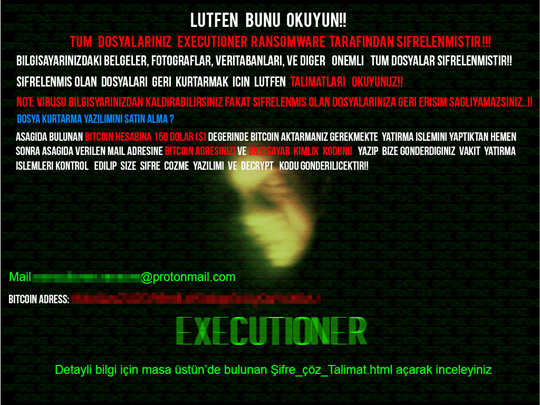RANSOM_HIDDENTEAREXECU.A
Ransom.HiddenTear!g1(Norton);Ransom:MSIL/Ryzerlo.A(Microsoft)
Windows


Threat Type: Ransomware
Destructiveness: No
Encrypted: No
In the wild: Yes
OVERVIEW
Downloaded from the Internet
This Ransomware arrives on a system as a file dropped by other malware or as a file downloaded unknowingly by users when visiting malicious sites.
It deletes itself after execution.
It encrypts files with specific file extensions. It drops files as ransom note.
TECHNICAL DETAILS
118,784 bytes
EXE
No
04 Jun 2017
Encrypts files, Displays message/message boxes
Arrival Details
This Ransomware arrives on a system as a file dropped by other malware or as a file downloaded unknowingly by users when visiting malicious sites.
Installation
This Ransomware drops the following files:
- C:\Users\{username}\ransom.jpg
Other System Modifications
This Ransomware changes the desktop wallpaper by modifying the following registry entries:
HKEY_CURRENT_USER\Control Panel\Desktop
Wallpaper = C:\Users\{username}\ransom.jpg
It sets the system's desktop wallpaper to the following image:
Information Theft
This Ransomware gathers the following data:
- Computer name
- Username
- Key
Stolen Information
This Ransomware sends the data it gathers to the following email addresses via SMTP:
- {BLOCKED}ransom@protonmail.com
Other Details
This Ransomware deletes itself after execution.
Ransomware Routine
This Ransomware encrypts files with the following extensions:
- .txt
- .doc
- .docx
- .xls
- .xlsx
- .ppt
- .pptx
- .odt
- jpeg
- .png
- .csv
- .sql
- .mdb
- .sln
- .php
- .asp
- .aspx
- .html
- .xml
- .psd
- .sql
- .mp4
- .7z
- .rar
- .m4a
- .wma
- .avi
- .wmv
- .csv
- .d3dbsp
- .zip
- .sie
- .sum
- .ibank
- .t13
- .t12
- .qdf
- .gdb
- .tax
- .pkpass
- .bc6
- .bc7
- .bkp
- .qic
- .bkf
- .sidn
- .sidd
- .mddata
- .itl
- .itdb
- .icxs
- .hvpl
- .hplg
- .hkdb
- .mdbackup
- .syncdb
- .gho
- .cas
- .svg
- .map
- .wmo
- .itm
- .sb
- .fos
- .mov
- .vdf
- .ztmp
- .sis
- .sid
- .ncf
- .menu
- .layout
- .dmp
- .blob
- .esm
- .vcf
- .vtf
- .dazip
- .fpk
- .mlx
- .kf
- .iwd
- .vpk
- .tor
- .psk
- .rim
- .w3x
- .fsh
- .ntl
- .arch00
- .lvl
- .snx
- .cfr
- .ff
- .vpp_pc
- .lrf
- .m2
- .mcmeta
- .vfs0
- .mpqge
- .kdb
- .db0
- .dba
- .rofl
- .hkx
- .bar
- .upk
- .das
- .iwi
- .litemod
- .asset
- .forge
- .ltx
- .bsa
- .apk
- .re4
- .sav
- .lbf
- .slm
- .bik
- .epk
- .rgss3a
- .pak
- .big
- wallet
- .wotreplay
- .xxx
- .desc
- .py
- .m3u
- .flv
- .js
- .css
- .rb
- .p7c
- .pk7
- .p7b
- .p12
- .pfx
- .pem
- .crt
- .cer
- .der
- .x3f
- .srw
- .pef
- .ptx
- .r3d
- .rw2
- .rwl
- .raw
- .raf
- .orf
- .nrw
- .mrwref
- .mef
- .erf
- .kdc
- .dcr
- .cr2
- .crw
- .bay
- .sr2
- .srf
- .arw
- .3fr
- .dng
- .jpe
- .jpg
- .cdr
- .indd
- .ai
- .eps
- .pdd
- .dbf
- .mdf
- .wb2
- .rtf
- .wpd
- .dxg
- .xf
- .dwg
- .pst
- .accdb
- .mdb
- .pptm
- .pptx
- .ppt
- .xlk
- .xlsb
- .xlsm
- .xlsx
- .xls
- .wps
- .docm
- .docx
- .doc
- .odb
- .odc
- .odm
- .odp
- .ods
- .odt
- .png
- .jpg
- .rtf
- .mpg
- .mp3
It avoids encrypting files with the following strings in their file path:
- Program Files
- Program Files (x86)
- Windows
It appends the following extension to the file name of the encrypted files:
- .{6 random characters}
It drops the following file(s) as ransom note:
- {Encrypted File path}\Sifre_Coz_Talimat.html
NOTES:
It displays the following ransom note:

SOLUTION
9.850
13.454.01
05 Jun 2017
13.455.00
06 Jun 2017
Step 1
Before doing any scans, Windows XP, Windows Vista, and Windows 7 users must disable System Restore to allow full scanning of their computers.
Step 2
Note that not all files, folders, and registry keys and entries are installed on your computer during this malware's/spyware's/grayware's execution. This may be due to incomplete installation or other operating system conditions. If you do not find the same files/folders/registry information, please proceed to the next step.
Step 3
Search and delete this file
- {Encrypted File path}\Sifre_Coz_Talimat.html
- C:\Users\{username}\ransom.jpg
Step 4
Scan your computer with your Trend Micro product to delete files detected as RANSOM_HIDDENTEAREXECU.A. If the detected files have already been cleaned, deleted, or quarantined by your Trend Micro product, no further step is required. You may opt to simply delete the quarantined files. Please check this Knowledge Base page for more information.
Step 5
Reset your Desktop properties
Step 6
Restore encrypted files from backup.
Did this description help? Tell us how we did.


